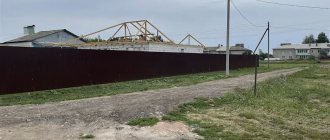Home / Real estate / Land / Use, ownership / Right to use land
Back
Published: 02/15/2017
Reading time: 10 min
4
2879
On the territory of any SNT there are lands of two different categories: those that belong to citizens and the partnership as a legal entity.
If gardeners own their plots as owners and can dispose of them at their own discretion, then with public lands the situation is somewhat different.
- Legislation
- What are public lands in SNT
- The procedure for using common land SNT
- What violations may occur when using the common land of SNT and responsibility for them
Legislation
The procedure for using public lands is contained in the Civil Code and the Land Code.
Here are general provisions governing the use of publicly accessible lands, as well as the procedure for transferring them into the ownership of SNT.
Separate provisions regarding the legal status of public lands, taking into account the specifics of SNT, are given in Federal Law-66.
The latest version of the law dates back to 2016.
Public lands have the following features:
- they are not covered by the so-called “Dacha Amnesty” (simplified privatization procedure);
- according to the Federal Law “On Gardening Associations of Citizens”, land that is public property is transferred to SNT free of charge;
- The Land Code does not limit SNT members on the terms of use of plots.
Limit dimensions
Depending on the category of land, maximum minimum and maximum sizes of land plots may be established for land plots. Article 11.9 of the Land Code establishes that the minimum and maximum dimensions of a plot are established by local urban planning rules in the event that such urban planning rules apply to the relevant lands (that is, the land plot is located within the boundaries of a populated area). In addition to the maximum dimensions, the town planning regulations also stipulate other parameters of the site:
- Percentage of territory development;
- Dimensions (height) of buildings;
- The size of the indentations of buildings from the boundaries of the land plot;
- Building density and other urban planning parameters (Article 38 of the Urban Planning Code of the Russian Federation).
Urban planning regulations (land use and development rules) are established by the administration of a constituent entity of the Russian Federation or the local administration of the corresponding municipal entity.
For agricultural land plots, the maximum sizes are established in accordance with Federal Law No. 101-FZ of July 24, 2002 “On the turnover of agricultural land.” The specific sizes of plots can be determined by the law of the subject of the Federation (region, territory, republic).
Taking into account the requirements established by regulatory documents (SNiP, fire safety requirements), the minimum area of land in SNT suitable for construction is 3 acres. Such a territory allows you to build a house while maintaining the required distances from the nearest plots. Typically, the size of plots in SNT ranges from 4 to 5 acres.
The article provides general information about the content of the legislation. To get an answer to a specific question, please contact an attorney.
What are public lands in SNT
The Civil Code indicates that the status of public land is given to plots that are in state/municipal ownership and on which citizens can stay without the need to obtain permits.
Such lands on the territory of SNT may include alleys, passages, roads, platforms, driveways, sanitary protection zones and reservoirs (including fire stations).
They can accommodate facilities aimed at meeting the needs of residents (for example, power lines, pipelines, gas pipelines, gatehouses, SNT board rooms, water pumps, utility rooms).
The area of public land is calculated as follows: from the total area allocated for the formation of SNT, the area of land that is owned by citizens is subtracted.
Such plots are the collective property of partnerships, or are assigned to them on the basis of perpetual use rights.
For unhindered use of land, the SNT board must have title documents on hand: an act on the transfer of land into ownership or securing the right to permanent, perpetual use.
Free privatization: who can exercise the right and under what conditions
The opportunity to register a SNT land plot as a property is available to citizens who have reached the age of majority. The exception is cases when the land was transferred to minor citizens by a member of the partnership by inheritance. A prerequisite is full civil capacity. When submitting an application, he will have to confirm the ownership of the plot with documents (we announced the list of documents above).
You can privatize a plot of land for free provided that:
- the plot is located within the boundaries of the SNT territory;
- the land was transferred to the gardening partnership before the adoption of the Land Code of the Russian Federation (before November 10, 2001);
- the allotment was assigned to the user by decision of the general meeting as a result of the adoption of another document by which the allotments were distributed among the participants of the association;
- the land was not withdrawn from circulation; no decision was made regarding the allotment on reservation for the needs of the state or municipality.
In the latter case, the land is allowed to be transferred to the user without bidding solely under a lease agreement. The land user should pay attention to the fee. Its amount cannot be greater than the amount of land tax paid by owners of similar plots.
If we are talking about land transferred to the partnership after the entry into force of the Land Code of the Russian Federation, registration
Ownership of
such is possible only for money. It is handed over to the user after concluding a purchase and sale agreement with the municipality.
The procedure for using common land SNT
Today, SNT has two options for registering ownership rights to common property (Article 28 of the SNT Law):
- as the property of an SNT legal entity;
- common property of the members of the association.
It is worth noting that only registration of ownership rights and not lease is allowed for such plots.
The right to choose the privatization option belongs to the members of the SNT. If they choose
registration of common ownership, then joint and shared ownership are allowed. In the first case, one application for privatization is submitted, signed by all members of the SNT. In the second case, it is submitted by each citizen indicating his share. The minutes of the meeting of the members of the partnership must be attached to the application.
At the same time, citizens cannot be forced to privatize public lands. If such areas are allocated to SNT on the basis of perpetual use rights, then it does not terminate its validity without the desire of SNT.
In practice, re-registration of land ownership has certain advantages for gardeners:
- the lands are transferred to the ownership of the partnership free of charge;
- lands that are registered in the cadastral register have clear boundaries and this eliminates the temptation for squatting and the emergence of disputes between plot owners and gardeners;
- SNT will be able to officially register all buildings on common land, erected from contributions from gardeners;
SNT has the opportunity to dispose of lands at its own discretion:
- build them up
- rent out
- sell and increase gardeners' plots.
The procedure for using land is contained in the charter of the partnership. Each section here usually has its own functionality assigned. For example, the arrangement of roads and passages, parking lots, reservoirs for fire safety purposes, recreation areas, wells, sports and children's playgrounds, recreational areas, sanitary zones, water supply sources, power lines, etc.
Members of the SNT have the right to use the land solely taking into account its intended purpose.
At the same time, no advantages are provided for the owners of plots bordering public land; they do not have a priority right to it.
Citizens have the right to contact members of the SNT board with a request to allocate them
lands for temporary use. In his application, the citizen must indicate the purposes of use, the period for which the land will be needed to implement the assigned tasks (no more than a month). Typically, the SNT charter contains a requirement for prior notification of members of the partnership of their desire to use the site at least two weeks to a month in advance.
When making decisions, the board will be guided by the interests and legal rights of the members of the partnership. For example, if an applicant plans to install a toilet or shower there, then he is more likely to be refused.
If during the work a piece of land is damaged, the user is obliged to carry out restoration work at his own expense.
Usually the site is provided for temporary use free of charge. But in some cases, chairmen impose a certain social burden on the applicant. For example, they demand that vegetation be trimmed.
Find out everything about invalidating a land purchase and sale agreement in our material. What consequences will you have if you refuse privatization? Our article is just about this! You can read how to properly formalize the termination of a gift agreement by following the link.
Can't find requested page.
The web-server couldn't locate the page you requested. To find the page you can use a search or site map.
- In Odintsovo DRSU, on the eve of the professional holiday, the best road workers in the district were awarded
- Andrei Ivanov instructed to prepare a roadmap for the repair of the entrance group of the psychoneurological dispensary in Zvenigorod
- More than 13 thousand studies have been carried out at the Odintsovo Center for Outpatient Oncology Care since the beginning of the year
- Decision of the Council of Deputies of the Odintsovo City District of the Moscow Region dated September 29, 2021 No. 12/28
- Decision of the Council of Deputies of the Odintsovo City District of the Moscow Region dated September 29, 2021 No. 11/28
- Decision of the Council of Deputies of the Odintsovo City District of the Moscow Region dated September 29, 2021 No. 8/28
- Decision of the Council of Deputies of the Odintsovo City District of the Moscow Region dated September 29, 2021 No. 7/28
- Decision of the Council of Deputies of the Odintsovo City District of the Moscow Region dated September 29, 2021 No. 6/28
- Decision of the Council of Deputies of the Odintsovo City District of the Moscow Region dated September 29, 2021 No. 5/28
- Decision of the Council of Deputies of the Odintsovo City District of the Moscow Region dated September 29, 2021 No. 4/28
- News Press archive
- Press center messages
- Story
- Municipal periodicals
- Investment project questionnaire
- Adverse weather conditions
- Information How to get there
- Museums
- Attention entrepreneurs
- Industry (brief information)
- Timetables Zvenigorod
- Announcement
- Structure
- Annual address of the Chapter
- Housing and communal services Lighting News
- Public services
- Odintsovo urban district
- Financial and treasury department
- Budget execution report for 2013
- Reports on the results of control activities
- Anti-Terrorism Commission
- Anti-corruption expertise










